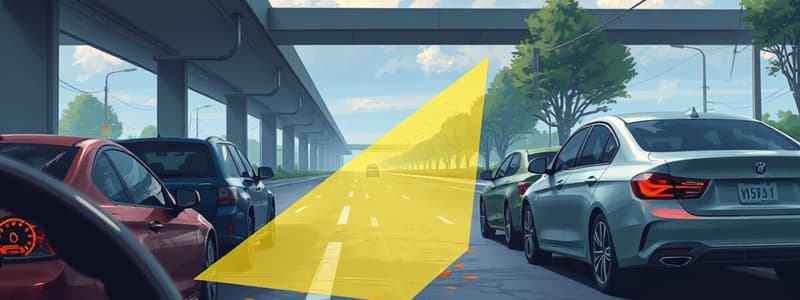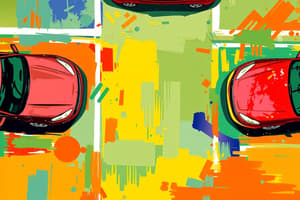Podcast
Questions and Answers
What is parallel parking where the front wheels are turned to prevent the vehicle from rolling downhill when left unattended?
What is parallel parking where the front wheels are turned to prevent the vehicle from rolling downhill when left unattended?
hill parking
What is parking at a right angle to the curb called?
What is parking at a right angle to the curb called?
perpendicular parking
What maneuver is used to turn your vehicle around so you can go in the opposite direction?
What maneuver is used to turn your vehicle around so you can go in the opposite direction?
turnabout
What type of mirror allows the driver a wider view of the side and rear of the vehicle?
What type of mirror allows the driver a wider view of the side and rear of the vehicle?
What parking technique requires a space about six feet longer than the vehicle being parked?
What parking technique requires a space about six feet longer than the vehicle being parked?
When should steering begin during a maneuver?
When should steering begin during a maneuver?
What is parking diagonally to a curb called?
What is parking diagonally to a curb called?
What is defined as some part of the outside or inside of the vehicle that relates to some part of the roadway from the driver's seat?
What is defined as some part of the outside or inside of the vehicle that relates to some part of the roadway from the driver's seat?
What is a common reference point on the vehicle typically used by most drivers?
What is a common reference point on the vehicle typically used by most drivers?
What is a unique part on a vehicle sometimes used by drivers as a reference point?
What is a unique part on a vehicle sometimes used by drivers as a reference point?
How do you turn your wheels when parked uphill with a curb?
How do you turn your wheels when parked uphill with a curb?
How do you turn your wheels when parked uphill with no curb?
How do you turn your wheels when parked uphill with no curb?
How do you turn your wheels when parked downhill with a curb?
How do you turn your wheels when parked downhill with a curb?
How do you park when you are downhill with a curb?
How do you park when you are downhill with a curb?
How do you park when you are downhill with no curb?
How do you park when you are downhill with no curb?
What is the instruction to drive in a straight line either forward or backward?
What is the instruction to drive in a straight line either forward or backward?
What should you do when backing in a straight line?
What should you do when backing in a straight line?
How can you check for a vehicle in your mirrors' blind spot?
How can you check for a vehicle in your mirrors' blind spot?
A common error in lane changing is understeering.
A common error in lane changing is understeering.
When planning a turn, what should you do?
When planning a turn, what should you do?
When backing to the right, a wide space on the right is necessary because the front of the vehicle will swing to the right.
When backing to the right, a wide space on the right is necessary because the front of the vehicle will swing to the right.
A U-turn is risky because several lanes of traffic must be crossed to execute the turn.
A U-turn is risky because several lanes of traffic must be crossed to execute the turn.
The driver of a vehicle leaving a parallel parking space must yield to all approaching traffic.
The driver of a vehicle leaving a parallel parking space must yield to all approaching traffic.
A three-point turnabout should only be used on a dead-end street or a rural roadway with no driveways.
A three-point turnabout should only be used on a dead-end street or a rural roadway with no driveways.
Which turnabout requires a wide space because no backing is done?
Which turnabout requires a wide space because no backing is done?
Which turnabout is used when there is a driveway on the right and no traffic behind?
Which turnabout is used when there is a driveway on the right and no traffic behind?
Which turnabout requires you to back across two lanes of traffic?
Which turnabout requires you to back across two lanes of traffic?
Which turnabout requires that you back into the traffic flow before moving forward?
Which turnabout requires that you back into the traffic flow before moving forward?
Which turnabout requires that you stop your car across traffic lanes?
Which turnabout requires that you stop your car across traffic lanes?
What should your hand position be if you are steering straight backward?
What should your hand position be if you are steering straight backward?
What should your hand position be if you are changing lanes?
What should your hand position be if you are changing lanes?
What should your hand position be if you are beginning to back to the right?
What should your hand position be if you are beginning to back to the right?
What should your hand position be if you are signaling with your hand for a left turn?
What should your hand position be if you are signaling with your hand for a left turn?
What should your hand position be if you are checking the right blind spot?
What should your hand position be if you are checking the right blind spot?
What should your hand position be if you are beginning to back to the left?
What should your hand position be if you are beginning to back to the left?
What should your hand position be if you are checking the left blind spot?
What should your hand position be if you are checking the left blind spot?
What should your hand position be if you are signaling with your hand for a right turn?
What should your hand position be if you are signaling with your hand for a right turn?
What should your hand position be if you are signaling with your hand to slow or stop?
What should your hand position be if you are signaling with your hand to slow or stop?
What should your hand position be if you are preparing to begin to parallel park?
What should your hand position be if you are preparing to begin to parallel park?
What should your hand position be if you are exiting a parallel parking space on the left side of a one-way street?
What should your hand position be if you are exiting a parallel parking space on the left side of a one-way street?
What should your hand position be if you are crossing a railroad track?
What should your hand position be if you are crossing a railroad track?
Position your vehicle in the______ lane.
Position your vehicle in the______ lane.
Apply gentle ______ pressure to reduce speed.
Apply gentle ______ pressure to reduce speed.
Check the front, rear, left, and right ______ zones.
Check the front, rear, left, and right ______ zones.
What should you search for in addition to traffic?
What should you search for in addition to traffic?
Slow to about 10 mph just before a ______.
Slow to about 10 mph just before a ______.
For a right turn, check to the ______ again before turning.
For a right turn, check to the ______ again before turning.
Turn the steering wheel when your vehicle's ______ wheels are even with the bend of the corner.
Turn the steering wheel when your vehicle's ______ wheels are even with the bend of the corner.
For a left turn, make a check right, then left. Turn the steering wheel just before you reach the ______ of the intersection.
For a left turn, make a check right, then left. Turn the steering wheel just before you reach the ______ of the intersection.
Turn into the ______ lane of traffic going in your direction.
Turn into the ______ lane of traffic going in your direction.
Then ______ about halfway through the turn.
Then ______ about halfway through the turn.
Before entering a parking space, how far should vehicles be positioned from the parked vehicles on the right?
Before entering a parking space, how far should vehicles be positioned from the parked vehicles on the right?
Before pulling into the parking stall, how much distance should be between your vehicle and the vehicle on the right?
Before pulling into the parking stall, how much distance should be between your vehicle and the vehicle on the right?
What are two ways to communicate your intention in a parking lot?
What are two ways to communicate your intention in a parking lot?
Before parallel parking into a parking stall, which bumper do you use to line up with the vehicle on your right?
Before parallel parking into a parking stall, which bumper do you use to line up with the vehicle on your right?
When exiting, when should you begin to turn the vehicle's wheels?
When exiting, when should you begin to turn the vehicle's wheels?
What is the recommended hand position on the steering wheel?
What is the recommended hand position on the steering wheel?
How many collisions occur during a car accident?
How many collisions occur during a car accident?
How much room do you need to parallel park?
How much room do you need to parallel park?
When do you start straightening your car in a turn?
When do you start straightening your car in a turn?
Flashcards are hidden until you start studying
Study Notes
Parking Techniques
- Hill Parking: Front wheels turned to prevent rolling downhill when left unattended.
- Perpendicular Parking: Parking at a right angle to the curb.
- Angle Parking: Parking diagonally to a curb.
- Parallel Parking: Requires about six feet longer than the vehicle being parked.
Maneuvering Methods
- Turnabout: A maneuver to turn the vehicle around to go in the opposite direction.
- Reference Points: Observational cues inside or outside the vehicle related to the roadway.
Mirrors and Visibility
- Convex Mirror: Offers a wider view of the side and rear of the vehicle.
- Standard Reference Points: Common reference points used by most drivers.
- Personal Reference Point: Unique parts of the vehicle chosen by individual drivers.
Steering and Hand Positions
- Hand Position for Backward Steering: Left hand on the steering wheel, right arm on the seat.
- Correct Lane Change: Both hands on the steering wheel in a balanced position.
- Signaling Turns: Specific hand positions for signaling left or right turns.
Parking Directions
- Uphill with a Curb: Turn wheels to the left.
- Uphill without a Curb: Turn wheels to the right.
- Downhill with a Curb: Turn wheels to the right.
- No Curb: Always turn wheels to the right when downhill.
Safety Checks
- Blind Spot Check: Look over your shoulder in the direction you wish to move.
- Check Traffic Zones: Always clear rear and surrounding zones before maneuvering.
Errors in Driving
- Lane Changing: Not required to check blind spots if mirrors have been checked is incorrect.
- Three-Point Turnabout: Only safe on dead-end streets or rural areas without driveways.
Communication in Parking Lots
- Signal Intentions: Use turn signals and flash green lights to communicate with other drivers.
Collisions
- Types of Collisions: Each car accident involves three collisions: the car against an object, the occupant against the car, and internal organ impacts.
General Driving Tips
- Driving Straight: Hold the steering wheel steady for forward or backward motion.
- Exiting Parallel Park: Begin to turn wheels when the front bumper is even with the rear bumper of the car next to you.
- Parallel Parking Distance: Need about six feet of space to park effectively.
Studying That Suits You
Use AI to generate personalized quizzes and flashcards to suit your learning preferences.




